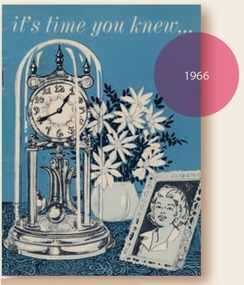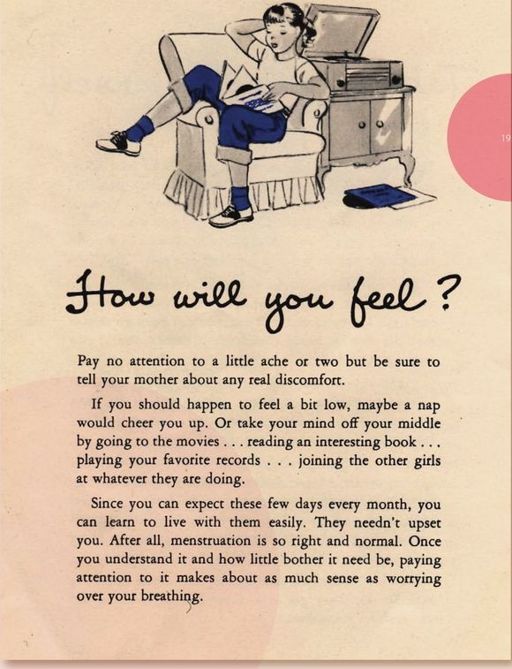Flow: The Cultural Story of Menstruation (24 page)
Read Flow: The Cultural Story of Menstruation Online
Authors: Elissa Stein,Susan Kim
Tags: #Health; Fitness & Dieting, #Women's Health, #General, #History, #Historical Study & Educational Resources, #Politics & Social Sciences, #Women's Studies, #Personal Health, #Social History, #Women in History, #Professional & Technical, #Medical eBooks, #Basic Science, #Physiology

Tampax, Procter & Gamble Company

In the 1920s, femcare companies dished out free samples and booklets like candy corn on Halloween. The woman-to-woman faux educational tone seeped into their print ads, as well:
—KOTEX AD (1926)
| Blonde: | “Whenever I think over the handi- caps nature handed to women, I just boil.” |
| Brunette: | “I wouldn’t talk that way, Fran, especially not around a young daughter.” |
| Blonde: | “That’s just what riles me. Here Grace is just twelve, and has to go through this miserable uncomfort able time—rubbing … chafing …” |
| Brunette: | “Why Fran, dear, why don’t you get that child a box of the new Kotex. It’s as soft as down.” |
Modess, Johnson & Johnson

But why go through a motherly middleman? Femcare companies quickly figured out it made more sense to market directly to the girls themselves. In one swift move, menstrual education was effectively yanked from the hands of mothers and taken over by commercial manufacturers.
Schools became the new venue for educating new generations of shoppers, with menstruation now comfortably marketed as an issue of hygiene, not fertility. Femcare manufacturers began producing not only promotional booklets, but short films, as well. While the hairstyles, music, and fashion have changed over time, these films have followed the same structure for decades: after a clinical description of the menstrual cycle and female reproductive anatomy, including information on hygiene, hormones, and physical changes during puberty, every film ends with a “how-to” that shamelessly plugs the sponsor’s product. Even Walt Disney produced an animated film for Kotex in the 1940s, in which adolescents who bore an eerie resemblance to Cinderella and Snow White pondered the mysteries of growing up.
A girl and her parents had no choice over which educational film she’d be shown in fifth-grade assembly; the femcare companies, after all, dealt directly with the schools themselves. And the competition occasionally grew a tad testy, especially when it came to the question of which was the best product for young girls: pads or tampons?
The pro-tampon arguments flew like right hooks in a bare-knuckled prizefight:
There are two odor problems you can have during your period. One is body odor—for you perspire more profusely during your period.
That is why daily baths are so important and deodorants should be used. The other problem is menstrual odor—which may form when pads are worn. You can avoid menstrual odor entirely, however, when you wear a tampon.
—“ACCENT ON YOU,” TAMPAX BOOKLET (1966)
And:
Bulky, soiled pads should never be flushed down the toilet, as this often clogs the plumbing. It is best to wrap them in paper and dispose of them discreetly. On visits, this isn’t always convenient. That’s one reason many girls turn to tampons which, because of their small size, are easily flushed away.
—“ACCENT ON YOU,” TAMPAX BOOKLET (1966)
The pad makers countered with the knockout punch, the ultimate roundhouse blow:
You’re a Young Lady Now, Kotex, Kimberly-Clark

Kotex, Kimberly-Clark

Well, frankly, most authorities say young girls shouldn’t use tampons without first consulting their doctors. The reason is this. In most girls, there’s usually a membrane called the hymen, which partly closes the entrance to the vagina—from which comes the menstrual flow.
Therefore, Kotex sanitary napkins are much more comfortable, and better suited to a young girl’s needs, than tampons of any type.
—“AS ONE GIRL TO ANOTHER,” KOTEX BOOKLET (1943)
It turned out that many people, including priests in the Catholic Church, honestly believed that not only were tampons potentially sexually arousing, far more seriously, when a girl inserted one for the first time, she would tear her hymen and lose her virginity. It’s astounding how many girls still believe this particular myth; as recently as 1990, Tampax ran an ad with the headline, “Are You Sure I’ll Still Be a Virgin?” In fact, the hymen is a stretchy little devil that doesn’t even totally cover the vagina (think about it: how could the blood get out otherwise?). And even in the incredibly rare instance of a girl actually tearing her hymen by inserting a tampon, what’s the big deal? After all, the only way anyone loses her virginity is through sexual intercourse, remember?
We appreciate commercially available femcare, we truly do; yet we are disturbed that by allowing manufacturers and their advertisers to be the ones to educate our pubescent daughters, nieces, and granddaughters about this crucial moment in their lives, we are instead letting them use shame and embarrassment freely, for the sole purpose of creating lifelong customers. With them, we have become complicit in treating menstruation as a monthly biological event we buy supplies for, and nothing more.
It was just after my twelfth birthday and I felt a gross, wet sensation in my underwear and pain in my lower back. I knew what was going on. I got a pad out of the closet by the bathroom and stuck it in. I called my mom at work. She got me a plant.
—Sophie M. (21)
What does it say about our society that all social, spiritual, and cultural significance has been, well, bled out of menarche?
BACK TO BASICS
M
ENSTRUATION IS A FUNNY PROCESS IN THAT it’s perhaps the only regular bodily event that is, more often than not, greeted with powerful emotion. At this very moment around the world, you can bet that countless females (and not a few of their significant others) are praying feverishly for the appearance of that telltale blood, or else dreading it with a heavy heart. In comparison, one doesn’t generally see people weeping with either relief or despair over, say, the sloughing of dead skin cells off their elbow, the growth of a new toenail, a bowel movement, or a good sneeze. Yet getting her period is something that can easily make a grown woman burst into racking sobs … or kick up her heels and order a fresh round of drinks for the house.
“I’m late!”
Is there a woman alive who doesn’t understand that particular code, perhaps one of the most resonant two-word phrases in our universal dictionary?
For heterosexually active females of childbearing age, menstruation has always served one immensely practical purpose: it’s the universal indicator that one is not pregnant … not yet, at any rate. Unlike the light spotting that pregnant women occasionally experience, a genuine three-to-five-day flow is about as clear a signal as you can get from your body that conception is still, at the very least, another cycle away.
Funnily enough, using one’s flow to determine whether or not one is pregnant is also where most women’s understanding of the whole process begins—and ends. The problem is not only that this is a severely limited definition of a decidedly complex and downright mysterious event, it isn’t even that accurate, either. The fact is, a woman can and often does menstruate without ovulating, and vice versa. Up to 80 percent of the menstrual cycles that occur during the first two years of a girl’s reproductive life happen without ovulation taking place. Similarly, older women in the later stages of perimenopause often have periods without ovulating, as well. On the flip side, it’s incredibly common for an amenorrheic woman, that is, someone who hasn’t had her period in months, to get pregnant, because despite her lack of menstrual flow, she was actually ovulating all along.
Even today, there’s astoundingly bad education about fertility, reproduction, and basic human physiology, resulting in widespread misinformation, confusion, and fear—even among people who should know better. We are routinely moved and appalled by the basic details so many teenage girls and young women don’t seem to know: that urine and menstrual flow emerge from two totally different openings, the urethra and the vagina, for example, or that having unprotected sex the week after one’s period is akin to begging to get knocked up.
To make matters worse, ignorance is clearly not just an issue for the very young. Overwhelmingly, women in their twenties and even seasoned old broads have many of the same questions that their prepubertal sisters have about this most basic of female functions. Many of these questions revolve around a shared yet unspoken fear, a prickling, secret suspicion that one is, in fact, a biological anomaly, some kind of medical freak: Is something wrong with me? Is this normal? Why is my cycle so irregular? Why are my cramps so painful/nonexistent, my flow so heavy/light, my mood so awful/ elated? Am I having a miscarriage? Is something wrong with me?
To be fair, what we still don’t know about menstruation could fill a small library. The big think tanks, universities, and research labs don’t traditionally spend any time, thought, or money on the hows and whys of normal, nonpathological menstruation. As a result, there’s a limit to how much we know definitively.
What’s more, menstruation is in fact a fairly unusual event in the natural world. As we mentioned earlier, other than humans, only some other primates and, weirdly enough, a few lucky bats and shrews get to menstruate at all. Contrary to popular belief, female dogs and cats don’t menstruate. Sure, some may bleed a little when in heat—which is why one occasionally catches the odd sight of that scary Rottweiler sporting a doggie menstrual pad—but they don’t undergo any of the cyclical hormonal and physiological changes that constitute a real period. Of the select group of menstruating mammals, humans also overwhelmingly bleed the most, far more than even the great apes.
As one probably remembers all too well from that film we were shown in the fifth grade, during the menstrual cycle, a human female produces one or more mature eggs, as her body gets locked and loaded in preparation for pregnancy. This is, however, a pretty singular event in the animal kingdom. There are other kinds of female adaptations when it comes to reproduction, the most common being “seasonal ovulation.”
